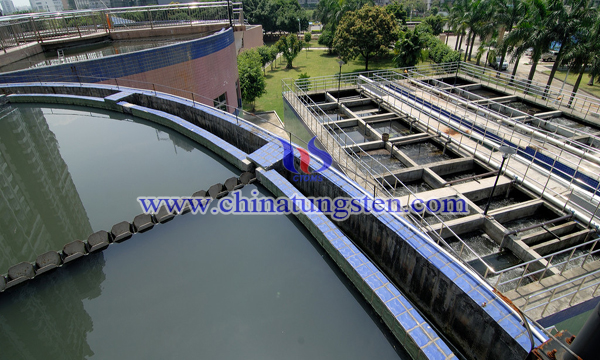Rare Earth Lanthanum Assisted Comprehensive Recycle of Tungsten Smelting Wastewater
- Details
- Category: Tungsten Information
- Published on Saturday, 17 February 2018 13:43
Most domestic tungsten smelters in China use "pressure cook - ion exchange - evaporation crystallization" process to produce ammonium tungstate. The advantages of ion-exchange process are stable product quality and easy operation. However, the major drawback of the process is that the water consumption is very large. The appointment of APT for 1 tons per ton produces 100~120 tons of wastewater.

Because tungsten smelters in China mostly use various non-standard concentrates as raw materials, such materials contain large amounts of phosphorus, arsenic and other harmful elements and a large number of flotation agents. Harmful substances are not adsorbed by resin in ion exchange process, and more than 95% of them enter wastewater. These harmful substances have a harmful effect on the whole process of APT production, especially for ion exchange process, which not only reduces the adsorption capacity of resin, but also affects the adsorption of tungstic acid by resin. Therefore, there are some tungsten elements in the waste water except for phosphorus and arsenic.
Some scholars have invented a method for the comprehensive recycle of tungsten smelting wastewater using rare earth lanthanum. At room temperature, LaCl3 solution is added directly to tungsten smelting wastewater. Phosphorus and tungsten in the waste water are precipitated by phosphotungstate and lanthanum tungstate particles. The general process is as follows:
1. The tungsten smelting wastewater is mixed with LaCl3 and stirred, and the first mixed solution is obtained.
2. The pH value of the first mixed solution is adjusted, and the mixed solution after pH is obtained.
3. Adding flocculant in the mixed solution after adjusting the pH value, flocculating and settling, then filtrating, so as to get flocculent and supernatant.
4. The flocculation is treated by alkali hydrolysis so as to obtain tungstate solution and precipitation mixture, and the precipitation mixture is mixed with acid to obtain phosphate compounds.
The amount of LaCl3 solution is not limited, so long as it can react with phosphorus and tungsten to make it fully precipitated, it can be adjusted according to the content of phosphorus and tungsten in waste water. The amount of LaCl3 is 1.8 times as much as the theoretical amount. If the amount of LaCl3 solution is too small, the precipitation rate will not be high, and the recycle rate is not high. If the addition of LaCl3 solution is too high, the recycle rate will increase, but the economic cost will also increase correspondingly.
The amount of LaCl3 solution is not limited, so long as it can react with phosphorus and tungsten to make it fully precipitated, it can be adjusted according to the content of phosphorus and tungsten in waste water. The amount of LaCl3 is 1.8 times as much as the theoretical amount. If LaCl3 solution is added too little will lead to the precipitation rate is not high, the recycle rate is not high, and if LaCl3 solution is too much, the recycle rate increased, but the corresponding increase in economic costs. Proposed by the inventors of the invention, 1.8 times the theoretical amount of LaCl3 solution is added to the waste water of tungsten smelting, and the reaction is carried out for 5 minutes under the conditions of a stirring rate of 90r / min and a pH value of 7.2 to 7.5, and LaCl3 can fully contact phosphorus and tungsten, more preferably, phosphorus and tungsten recycle can reach 95% or more, and only a small amount of unreacted LaCl3 remain in solution.
- Rare Earth Manufacturer & Supplier, Chinatungsten Online: www.chinatungsten.com
- Tungsten News & Prices of China Tungsten Industry Association: www.ctia.com.cn
- Molybdenum News & Price: news.molybdenum.com.cn
- Tel.: 86 592 5129696; Fax: 86 592 5129797; Email: sales@chinatungsten.com



 sales@chinatungsten.com
sales@chinatungsten.com